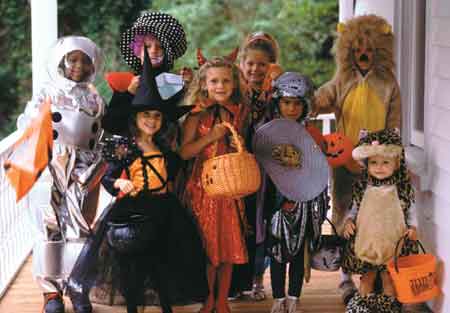万圣夜的主要活动是trick or treat(不给糖就捣乱)。小孩装扮成各种恐怖的样子,逐门逐户按响邻居的门铃,大叫:"Trick or treat!"(意即不请客就捣乱),主人家(可能同样穿着恐怖服装)便会拿出一些糖果、巧克力或是小礼物。部分家庭甚至使用声音特效和制烟机器营造恐怖气氛。小孩一晚取得的糖果往往以袋计算,整袋整袋的搬回家。
在苏格兰,小孩要糖果时会说:“The sky is blue, the grass is green, may we have our Halloween.”(天是蓝色,草是绿色,齐来庆祝万圣节前夜),然后以唱歌跳舞等表演来要糖果。
万圣节是儿童们纵情玩乐的好时候。它在孩子们眼中,是一个充满神秘色彩的节日。夜幕降临,孩子们便迫不及待地穿上五颜六色的化妆服,戴上千奇百怪的面具,提上一盏“杰克灯”跑出去玩。“杰克灯”的样子十分可爱,做法是将南瓜掏空,外面刻上笑眯眯的眼睛和大嘴巴,然后在瓜中插上一支蜡烛,把它点燃,人们在很远的地方便能看到这张憨态可掬的笑脸。
收拾停当后,一群群装扮成妖魔鬼怪的孩子手提“杰克灯”,跑到邻居家门前,威吓般地喊着:"trick or treat"。如果大人不用糖果、零钱款待他们,那些调皮的孩子就说到做到:好,你不款待,我就捉弄你。他们有时把人家的门把手涂上肥皂,有时把别人的猫涂上颜色。这些小恶作剧常令大人啼笑皆非。当然,大多数人家都非常乐于款待这些天真烂漫的小客人。所以万圣节前夜的孩子们总是肚子塞得饱饱的,口袋装得满满的。
万圣节前夜最流行的游戏是“咬苹果”。游戏时,人们让苹果漂浮在装满水的盆里,然后让孩子们在不用手的条件下用嘴去咬苹果,谁先咬到,谁就是优胜者。

Trick-or-treat
Trick-or-treat is a custom for children on Halloween. Children proceed in costume from house to house, asking for treats such as confectionery, or sometimes money, with the question, "Trick or treat?" The "trick" is an idle threat to perform mischief on the homeowners or their property if no treat is given.
In the United States, trick-or-treating is now one of the main traditions of Halloween and it has become socially expected that if one lives in a neighborhood with children one should purchase treats in preparation for trick-or-treaters. The National Confectioners Association reported in 2005 that 80 percent of adults in the United States planned to give out confectionery to trick-or-treaters,and that 93 percent of children planned to go trick-or-treating. The tradition of going from door to door receiving food already existed in Britain and Ireland, in the form of souling, where children and poor people would sing and say prayers for the dead in return for cakes.The North American Halloween custom of saying "trick or treat" has become more common. The activity is done in the United States, United Kingdom, Canada, Ireland, Puerto Rico, and northwestern Mexico.
The earliest known use in print of the term "trick or treat" appears in 1927, from Blackie, Alberta, Canada:
Hallowe’en provided an opportunity for real strenuous fun. No real damage was done except to the temper of some who had to hunt for wagon wheels, gates, wagons, barrels, etc., much of which decorated the front street. The youthful tormentors were at back door and front demanding edible plunder by the word “trick or treat” to which the inmates gladly responded and sent the robbers away rejoicing.
Trick-or-treating does not seem to have become a widespread practice until the 1930s, with the first U.S. appearances of the term in 1934, and the first use in a national publication occurring in 1939.
Increased popularity
Almost all pre-1940 uses of the term "trick-or-treat" are from the western United States and Canada.Trick-or-treating spread from the western United States eastward, stalled by sugar rationing that began in April 1942 during World War II and did not end until June 1947.
Early national attention to trick-or-treating was given in October 1947 issues of the children's magazines Jack and Jill and Children's Activities, and by Halloween episodes of the network radio programs The Baby Snooks Show in 1946 and The Jack Benny Show and The Adventures of Ozzie and Harriet in 1948. The custom had become firmly established in popular culture by 1952, when Walt Disney portrayed it in the cartoon Trick or Treat, Ozzie and Harriet were besieged by trick-or-treaters on an episode of their television show, and UNICEF first conducted a national campaign for children to raise funds for the charity while trick-or-treating.
Although some popular histories of Halloween have characterized trick-or-treating as an adult invention to rechannel Halloween activities away from vandalism, nothing in the historical record supports this theory. To the contrary, adults, as reported in newspapers from the mid-1930s to the mid-1950s, typically saw it as a form of extortion, with reactions ranging from bemused indulgence to anger. Likewise, as portrayed on radio shows, children would have to explain what trick-or-treating was to puzzled adults, and not the other way around. Sometimes even the children protested: for Halloween 1948, members of the Madison Square Boys Club in New York City carried a parade banner that read "American Boys Don't Beg."
Introduction to the UK
Before the 1980s, the North American phrase "trick-or-treat" was little known in the UK and when introduced was often regarded as an unusual and even unwelcome import, because "trick or treat" isn't a tradition, with Halloween an authentically ancient festival, about the links between life and death, the struggle between light and dark. In the 80s it was still viewed as an exotic and not particularly welcome import, referred to as "the Japanese knotweed of festivals".
(改编自:中青网英语角, wikipedia.org,英语点津Julie编辑)